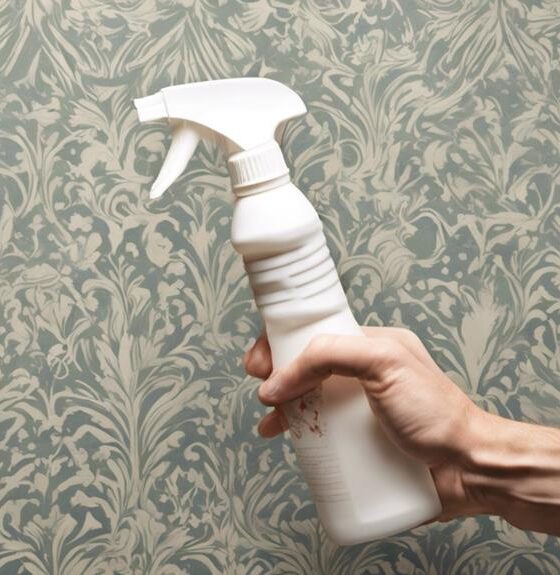Retreat
How Do You Remove Calcium Deposits From Hot Tub Walls

As a hot tub owner, I know the frustration that comes with stubborn calcium deposits lining the walls.
Did you know that these deposits can decrease the efficiency of your hot tub and affect the quality of your soak?
In this article, I will share my expertise on how to effectively remove calcium deposits from hot tub walls.
By following these steps, you can maintain a clean and enjoyable hot tub experience for yourself and your guests.
Key Takeaways
- Calcium deposits in hot tubs can clog the plumbing and circulation system, leading to decreased water flow and reduced efficiency.
- Regular removal and prevention of calcium deposits are necessary for optimal hot tub performance.
- Scrubbing with a soft brush and using acidic cleaners are effective ways to remove stubborn calcium deposits.
- Proper water chemistry maintenance, regular cleaning, and the use of water softeners or filtration systems can help prevent future calcium deposits in hot tubs.
Understanding Calcium Deposits in Hot Tubs
I’ve encountered numerous calcium deposits in my hot tub, and understanding them is crucial for proper maintenance.
Calcium deposits in hot tubs are formed when the water is saturated with calcium and other minerals. The primary cause of these deposits is hard water, which contains high levels of calcium and magnesium.
When the water is heated, the calcium and magnesium ions combine and form solid deposits on various surfaces, including the hot tub walls. These deposits can negatively impact hot tub performance in several ways.
Firstly, they can clog the plumbing and circulation system, leading to decreased water flow and reduced efficiency. Secondly, calcium deposits can cause damage to the hot tub’s heating element, leading to poor heating and increased energy consumption.
Therefore, it’s essential to regularly remove and prevent calcium deposits to maintain optimal hot tub performance.
Gathering the Necessary Supplies
What supplies do I need to gather in order to remove calcium deposits from hot tub walls?
To effectively clean the calcium buildup from your hot tub walls, you’ll need the following cleaning tools as part of your maintenance routine:
Acidic Cleaner: Look for a cleaner specifically designed to remove calcium deposits. These cleaners contain acids that break down the calcium buildup, making it easier to remove.

Soft Scrub Brush: A soft scrub brush will help you gently scrub away the calcium deposits without damaging the surface of your hot tub walls.
Microfiber Cloth: A microfiber cloth is ideal for wiping away the residue left behind after cleaning. It’s soft and absorbent, ensuring a streak-free finish.
Protective Gloves: To protect your hands from the acidic cleaner, wear protective gloves. These gloves will shield your skin from any potential irritation or harm.
Now that we’ve gathered the necessary supplies, let’s move on to the next step of scrubbing away the calcium buildup.
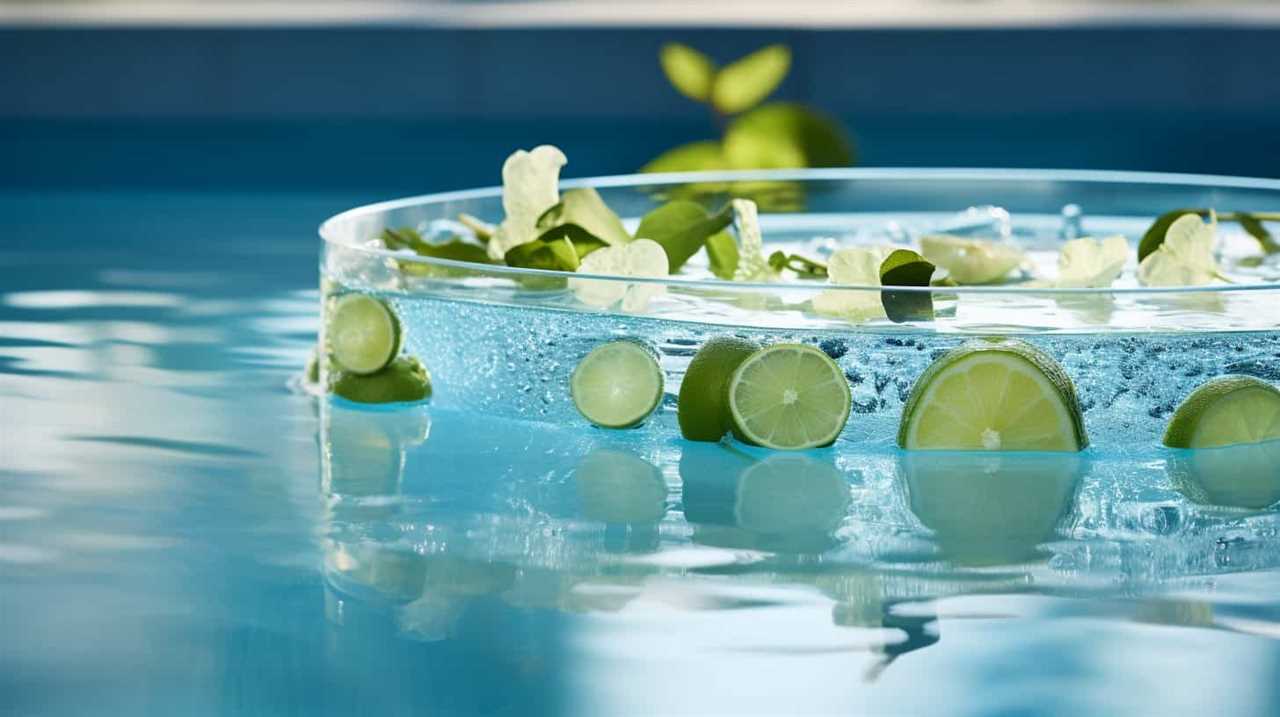
Scrubbing Away the Calcium Buildup
To effectively remove the calcium buildup from my hot tub walls, I’ll need to scrub it away using a soft scrub brush and an acidic cleaner. Cleaning techniques that involve scrubbing are often the most effective way to remove stubborn calcium deposits. The soft scrub brush allows for gentle yet thorough scrubbing without damaging the surface of the hot tub walls. It is important to choose an acidic cleaner specifically designed for removing calcium deposits. Acidic cleaners work by breaking down the calcium and dissolving it, making it easier to scrub away. Natural remedies such as vinegar or lemon juice can also be effective in removing calcium buildup. However, it is important to test these remedies in a small inconspicuous area first to ensure they do not damage the hot tub walls.
| Cleaning Techniques | Natural Remedies |
|---|---|
| Scrubbing with a soft brush | Vinegar |
| Using an acidic cleaner | Lemon juice |
| Testing in a small area first | |
| Gentle yet thorough scrubbing | |
| Breaking down and dissolving calcium |
Using Chemical Treatments for Stubborn Deposits
One effective method for removing stubborn calcium deposits from hot tub walls is to use a chemical treatment. Chemical treatments are specifically formulated to break down and dissolve calcium deposits, making them easier to remove.
Here are four key points to consider when using chemical treatments for stubborn deposits:
Choose the right chemical treatment: There are various options available on the market, so it’s important to select one that’s specifically designed for removing calcium deposits. Read the product labels and choose a treatment that’s safe for use in hot tubs.

Follow the instructions carefully: Chemical treatments can be potent, so it’s crucial to follow the recommended dosage and application instructions provided by the manufacturer. This will ensure optimal effectiveness and prevent any damage to your hot tub.
Consider alternative cleaning methods: While chemical treatments are effective, you may also explore alternative cleaning methods such as using a pumice stone or a stiff brush to gently scrub away the deposits. These methods can be used in conjunction with chemical treatments for better results.
Explore natural remedies: If you prefer to avoid chemical treatments, there are natural remedies like white vinegar or lemon juice that can help dissolve calcium deposits. These options may take longer and require more effort, but they’re environmentally friendly alternatives.
Preventing Future Calcium Deposits in Your Hot Tub
To prevent future calcium deposits in my hot tub, I’ll regularly monitor and maintain the water chemistry. One of the most important aspects of hot tub maintenance is maintaining the pH balance. The ideal pH level for a hot tub is between 7.2 and 7.8. If the pH level is too high or too low, it can lead to the formation of calcium deposits. By regularly testing the pH level and adjusting it as needed, I can prevent the buildup of calcium deposits.
Another way to prevent calcium deposits is by using a water softener in my hot tub. Water softeners help to remove minerals, including calcium, from the water. This reduces the likelihood of calcium deposits forming on the walls of the hot tub.
Regularly monitoring the water chemistry and using a water softener are essential steps in preventing future calcium deposits and maintaining a clean and enjoyable hot tub experience.
Frequently Asked Questions
Can I Use Regular Household Cleaning Products to Remove Calcium Deposits From Hot Tub Walls?
Yes, you can use regular household cleaning products to remove calcium deposits from hot tub walls. However, using vinegar as an alternative can be more effective and environmentally friendly. Professional cleaning products offer additional benefits such as increased efficiency and thoroughness.
How Often Should I Scrub the Hot Tub Walls to Prevent Calcium Buildup?
To prevent calcium buildup on hot tub walls, it’s important to regularly scrub them. I recommend draining the hot tub and scrubbing the walls at least once a month. Neglecting this maintenance can lead to long-term damage.
Are There Any Natural Remedies or Homemade Solutions to Remove Calcium Deposits From Hot Tub Walls?
I’ve found that homemade remedies and natural solutions can effectively remove calcium deposits from hot tub walls. These alternatives are cost-effective and environmentally friendly, making them a great option for anyone looking to maintain their hot tub.
Can I Use a Pressure Washer to Remove Calcium Deposits From Hot Tub Walls?
Using a pressure washer for hot tub maintenance can be effective but has pros and cons. It’s important to be cautious as excessive pressure can damage the walls. Consider alternative methods before resorting to pressure washing.
Is It Safe to Use Chemical Treatments for Stubborn Calcium Deposits if I Have Sensitive Skin or Respiratory Issues?
Using chemical treatments for stubborn calcium deposits in a hot tub may not be safe for those with sensitive skin or respiratory issues. It is important to consider alternative methods that do not pose a risk to your health.
Could Calcium Deposits be Causing My Hot Tub to Take Longer to Heat Up?
If you’ve noticed a longer hot tub heating time, calcium deposits could be to blame. These deposits can accumulate on the heating elements, causing them to work less efficiently. Regularly cleaning and maintaining your hot tub can help prevent this issue and ensure a faster heating time.
Conclusion
To tackle the troublesome task of removing calcium deposits from hot tub walls, gather the necessary supplies and scrub away with diligence.

Take it a step further by utilizing chemical treatments for those stubborn deposits.
And to ensure a calcium-free future, implement preventive measures.
By practicing these proactive techniques, you can enjoy a sparkling hot tub experience without the burden of pesky calcium buildup.
- About the Author
- Latest Posts
Introducing Charles, the Editor in Chief at ByRetreat, whose passion for interior design and editorial excellence elevates every remote workspace to new heights. With his keen eye for detail, impeccable taste, and expertise in design, Charles brings a wealth of knowledge and creativity to the ByRetreat team.
As the Editor in Chief of a renowned lifestyle blog, Charles has honed his skills in curating captivating content and staying up-to-date with the latest trends in interior design. His deep understanding of aesthetics and the power of storytelling through design enables him to create remote workspaces that are not only visually stunning but also rich in personality and meaning.
Retreat Ideas
Creative Corporate Retreat Gift Bag Ideas
Lure your attendees into a world of wonder with our imaginative corporate retreat gift bag ideas, each holding a special surprise in store.

Imagine stepping into a forest and discovering a treasure trove of surprises waiting at every turn. That's the essence of what we aim to achieve with our curated selection of corporate retreat gift bag ideas.
From personalized tech accessories to eco-friendly swag items, our suggestions are designed to elevate the experience for attendees and create lasting impressions.
Explore how these thoughtful touches can transform your corporate retreat gift bags into meaningful tokens that reflect the spirit of your event.
Key Takeaways
- Personalized tech accessories and branded utility items enhance corporate retreat gift bags.
- Locally sourced treats reflect the retreat location and support local businesses.
- Customized wellness products promote relaxation and well-being among participants.
- Eco-friendly swag items and sustainability-themed gifts reduce waste and support environmental consciousness.
Personalized Tech Accessories
When curating the ultimate corporate retreat gift bags, we infuse personalized tech accessories to seamlessly blend practicality with a touch of individuality. Our selection includes a range of branded items like custom smartphone cases, engraved USB drives, and personalized tech organizers, all adorned with the company logo to promote brand visibility. These modern and functional gifts cater to the tech-savvy needs of retreat attendees, offering not only a personalized touch but also enhancing their overall experience.
For a company looking to provide a memorable gift, custom Bluetooth earbuds, branded power banks, and personalized pop sockets are practical options that demonstrate thoughtfulness. Incorporating employee names or company mottos on tech accessories fosters a sense of ownership among recipients. From custom wireless chargers to engraved stylus pens, each item serves a purpose while adding a stylish flair to the gift bag. These personalized tech accessories aren't just gifts; they're tools that reflect the company's commitment to innovation and excellence.
Locally Sourced Treats

Elevating our corporate retreat gift bags to embody the essence of the retreat location, we introduce a delectable array of locally sourced treats that promise a flavorful journey through the region's culinary delights. Including artisanal chocolates, gourmet snacks, and specialty jams, these locally sourced treats offer a unique and authentic taste of the region, supporting local businesses and farmers while guaranteeing the community's economy and sustainability.
Our customized selection secures each gift bag reflects the flavors and specialties of the retreat location, adding a personal touch and cultural experience for each participant. By incorporating these locally sourced treats, we not only offer a delightful culinary experience but also showcase the diverse and rich food culture of the area.
From the rich cocoa notes of the artisanal chocolates to the savory crunch of gourmet snacks and the sweet tang of specialty jams, our gift bags are curated to provide a one-of-a-kind taste sensation that captures the essence of the retreat location.
Customized Wellness Products
Embracing the essence of relaxation and self-care at our corporate retreat, we curate gift bags filled with customized wellness products designed to enhance our participants' well-being and promote a sense of calm.
Our selection of wellness products includes:
- Aromatherapy Masks: Infused with calming scents, these masks help soothe the mind and body, perfect for unwinding after a long day of activities.
- Soothing Eye Pillows: These pillows provide gentle pressure and subtle aromatherapy to relieve tension and promote relaxation during moments of rest and reflection.
- Relaxation-Promoting Meditation Crystals: Each crystal is chosen for its calming properties, encouraging mindfulness and tranquility in daily practices.
In addition to these thoughtful items, we also include personalized water bottles, tote bags, and yoga accessories to support our participants' commitment to a healthy lifestyle. By offering practical and wellness-focused gifts, we aim to show appreciation for our employees' dedication while fostering a balanced and rejuvenating retreat experience.
Eco-Friendly Swag Items

Our commitment to sustainability shines through in the eco-friendly swag items carefully selected for our corporate retreat gift bags. By including reusable straws, we aim to foster eco-consciousness among attendees, encouraging them to make simple yet impactful changes in their daily routines. Plant-growing kits in canning jars not only offer a unique gift option but also symbolize growth and sustainability, inspiring participants to nurture both plants and a sense of environmental responsibility.
Moreover, providing reusable water bottles promotes waste reduction and supports eco-friendly practices during the retreat. These bottles serve as a reminder of the importance of reducing single-use plastics and embracing reusable alternatives. Additionally, eco-friendly bags included in the gift bags contribute to a more sustainable event experience, emphasizing our dedication to minimizing waste and promoting eco-conscious choices.
Together, these green gift options create a cohesive theme of sustainability, ensuring that our corporate retreat aligns with environmentally friendly principles and offers attendees a truly sustainable experience.
Innovative Team-Building Tools
To amplify the collaborative spirit at our corporate retreat, we infuse the gift bags with innovative team-building tools designed to energize and unite participants through engaging activities. Our selection includes:
- Custom Puzzles: These intricate puzzles not only challenge the mind but also promote teamwork as participants work together to solve them.
- Escape Room Kits: Transform any space into an escape room adventure, fostering problem-solving skills and encouraging cooperation among team members.
- Trivia Games: Fun and informative, these games spark friendly competition while enhancing communication and collaboration within the group.
Frequently Asked Questions
What Do You Put in a Gift Bag?
In a gift bag, we include items tailored to the recipient's preferences, creating a personalized experience. Our selection ranges from branded merchandise to eco-friendly options, wellness products, tech gadgets, and luxurious gifts, ensuring a memorable and impactful presentation.
What Is Another Name for a Staff Retreat?
Another term for a staff retreat is a team offsite. It's a designated time for us to step away, focus on team building, and enhance our collaboration skills. These retreats foster creativity, boost morale, and improve communication.
Conclusion
Just as each gift bag at a corporate retreat is carefully curated to enhance the experience for attendees, so too must we approach our own personal growth and development.
Like the contents of the gift bags, our journey is filled with personalized tech accessories, locally sourced treats, customized wellness products, eco-friendly swag items, and innovative team-building tools.
Let's embrace the creativity and thoughtfulness that goes into creating these gift bags and apply it to our own lives as we aim for growth and success.
- About the Author
- Latest Posts
Introducing Ron, the home decor aficionado at ByRetreat, whose passion for creating beautiful and inviting spaces is at the heart of his work. With his deep knowledge of home decor and his innate sense of style, Ron brings a wealth of expertise and a keen eye for detail to the ByRetreat team.
Ron’s love for home decor goes beyond aesthetics; he understands that our surroundings play a significant role in our overall well-being and productivity. With this in mind, Ron is dedicated to transforming remote workspaces into havens of comfort, functionality, and beauty.
Spa Design
What Design Elements Make MEO Suites and Spa Unique?
Get ready to uncover the mesmerizing design elements at MEO Suites and Spa that redefine luxury – the answer awaits within.
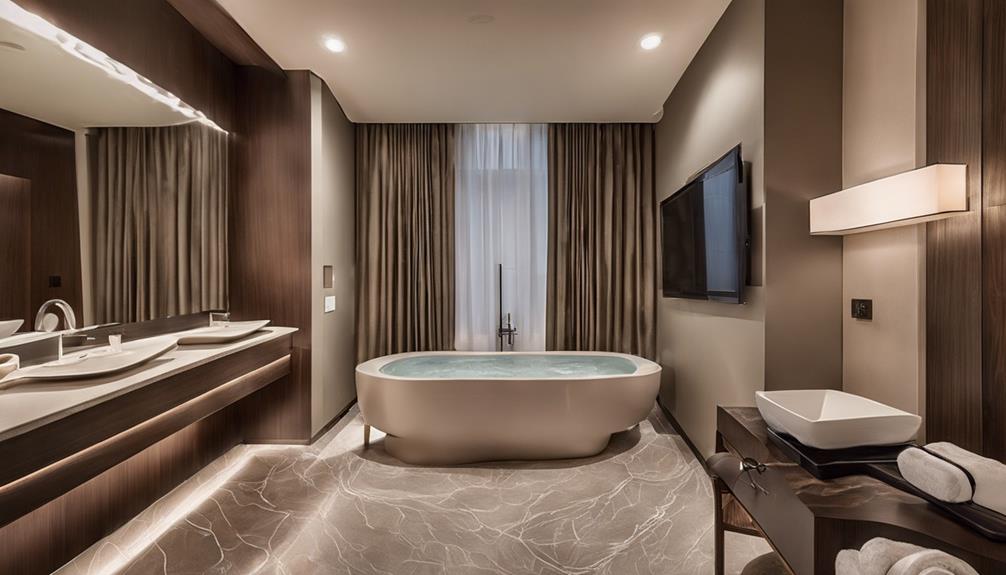
As we step into the world of MEO Suites and Spa, one cannot help but be captivated by the seamless fusion of modern luxury and cozy comfort.
From the moment you enter, the intricate play of natural textures and soothing colors beckons you to explore further.
Each corner whispers tales of thoughtful design and meticulous attention to detail, raising the question: what hidden treasures lie within these walls, waiting to be discovered?
Key Takeaways
- Luxurious interiors by Simona Cosentino redefine comfort and sophistication with Laminam slabs.
- Innovative spa and wellness facilities offer a transformative journey with luxurious amenities.
- Sustainable practices prioritize eco-friendly materials, energy efficiency, and green building principles.
- Artistic and cultural inspirations blend modern aesthetics with Catania dialect influences for personal intimacy.
Luxurious Interiors and Furnishings
Embracing opulence and elegance, the luxurious interiors and furnishings of MEO Suites and Spa, crafted by Simona Cosentino of Iraci Architetti, redefine the essence of comfort and sophistication. The design of the Meo Design Suites is a testament to a unique architectural language that prioritizes intimacy and the feeling of being at home. Laminam slabs play a pivotal role in creating a cohesive and visually striking aesthetic throughout the space. These slabs aren't just functional but serve as an integral design element, seamlessly blending with the overall ambiance.
The spa facilities within MEO are a harmonious blend of functionality and beauty, where the various textures, colors, sizes, and thicknesses of Laminam slabs are thoughtfully incorporated. The use of specific Laminam series such as I Naturali, Calce, and Seta adds a touch of sophistication and style to the overall design. Each detail is meticulously curated to enhance the guest experience, ensuring that every corner exudes luxury and comfort. The Meo Design Suites truly epitomize innovation in design, setting a new standard for luxury accommodation.
Innovative Spa and Wellness Facilities
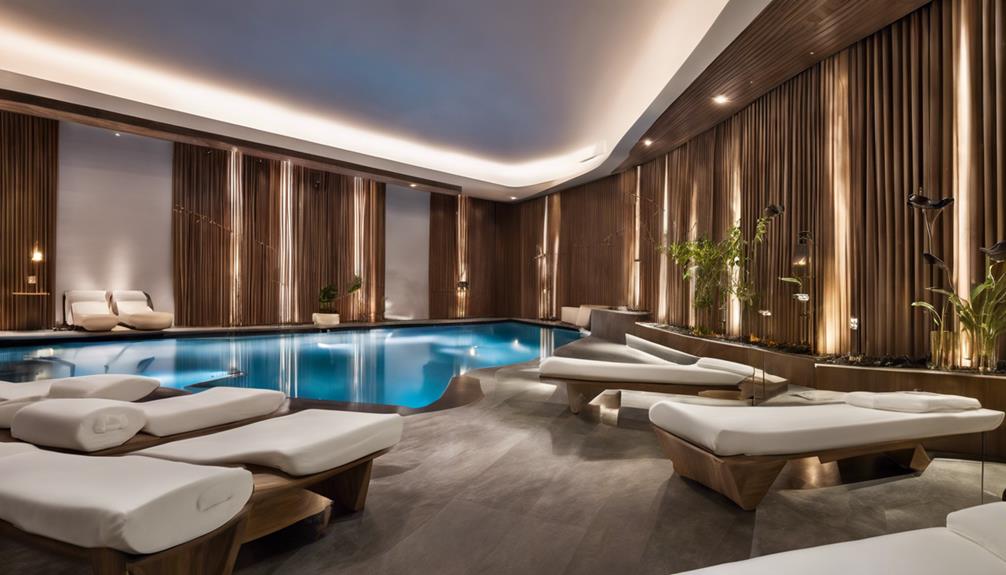
Crafting a sanctuary of rejuvenation and tranquility, MEO Suites and Spa's innovative spa and wellness facilities beckon guests to embark on a transformative journey of relaxation and well-being. The spa experience at MEO Suites is designed to offer a luxurious and holistic stay, ensuring guests leave feeling refreshed and rejuvenated.
Here are three features that make the spa facilities at MEO Suites stand out:
- Steam Room and Sauna: Guests can unwind in the steam room and sauna, indulging in the therapeutic benefits that promote relaxation and detoxification.
- Wellness Center: The wellness center at MEO Suites provides a range of services aimed at enhancing guests' overall well-being, from yoga classes to personalized wellness programs.
- Spa Amenities: MEO Suites' spa amenities offer a luxurious experience, with a variety of treatments and services available to cater to guests seeking a rejuvenating retreat.
Immersing oneself in the innovative spa and wellness facilities at MEO Suites promises a truly memorable and revitalizing experience.
Sustainable and Eco-Friendly Practices
At MEO Suites and Spa, our commitment to sustainability shines through in every aspect of our operations and design, exemplified by our incorporation of eco-friendly materials, energy-efficient systems, water conservation, recycled materials, responsible waste management, and adherence to green building principles. We believe in promoting sustainable practices to reduce our environmental footprint and contribute positively to the planet. Our eco-conscious approach extends to the very core of our establishment, from the construction of our suites to the daily operations of our spa facilities.
| Sustainable Practices | Description |
|---|---|
| Eco-Friendly Materials | Utilization of sustainable materials in design and construction processes |
| Energy-Efficient Systems | Implementation of systems to reduce energy consumption and increase efficiency |
| Water Conservation | Measures to conserve water resources and promote responsible usage |
Artistic and Cultural Inspirations

In our design narrative at MEO Suites and Spa, cultural echoes resonate through every curated detail, weaving a tapestry of artistic inspirations that pay homage to the historical essence of Catania, Italy.
The concept draws artistic inspiration from the Catania dialect, where 'Meo,' meaning 'mine,' encapsulates a sense of personal intimacy and ownership within the space.
Emphasizing personal intimacy and a sense of home, the interior design at MEO creates individual spaces within the hotel, fostering a unique connection between guests and their surroundings.
The architectural language at MEO showcases distinctive elements that set it apart from traditional hotel designs, blending cultural influences with modern aesthetics. Utilizing Laminam slabs in various textures, colors, and finishes adds a contemporary touch, enriching the interior design with a blend of tradition and innovation.
At MEO Suites and Spa, every corner reflects a harmonious fusion of artistic inspiration, personal intimacy, and architectural uniqueness, immersing guests in a cultural journey through the heart of Catania's heritage.
Personalized Guest Experiences
Echoing the cultural tapestry woven into every design detail at MEO Suites and Spa, personalized guest experiences emerge as a vibrant symphony of tailored services and individualized care. From the moment guests arrive, their preferences and needs are met with exceptional service, ensuring a feeling of being valued and well taken care of.
Each room is adorned with personal touches and unique amenities, creating a customized experience that resonates with every visitor. The meticulous attention to detail in guest interactions and services sets MEO Suites and Spa apart, offering a truly individualized stay that exceeds expectations.
Moreover, tailored recommendations and assistance from the staff elevate the overall guest experience, leaving a lasting impression that's both memorable and special. At MEO Suites and Spa, every guest is treated to a personalized journey, where their comfort and satisfaction are at the heart of every moment.
Frequently Asked Questions
What Are the Specific Amenities Included in the MEO Suites and Spa Rooms?
In our MEO Suites and Spa rooms, you'll find luxurious amenities like high-end linens, designer toiletries, and state-of-the-art technology. Our goal is to provide a lavish and comfortable experience for all our guests.
How Does MEO Suites and Spa Incorporate Local Culture Into Their Design and Services?
Incorporating local culture is our passion at MEO Suites and Spa. We infuse traditional art, cuisine, and customs into every detail. From handcrafted decor to authentic experiences, our design and services celebrate the rich heritage of our community.
Can Guests Request Customized Spa Treatments or Wellness Programs During Their Stay?
Absolutely! We offer personalized spa treatments and curated wellness programs for our guests. Whether it's a unique massage blend or a tailored fitness regime, we aim to provide a bespoke experience that caters to individual needs and preferences.
What Is the History Behind the Development of MEO Suites and Spa, and How Has It Evolved Over Time?
In the history of MEO Suites and Spa, our evolution has been a journey of transformation. From a vision of luxury to a reality of unparalleled hospitality, we have continuously refined our offerings to exceed expectations.
Are There Any Unique Partnerships or Collaborations That MEO Suites and Spa Has With Local Artists or Artisans?
Absolutely! We collaborate extensively with local artists and artisans, infusing their unique flair into our spaces. Their creativity breathes life into every corner, ensuring a stay that's not just luxurious but also culturally enriching.
Conclusion
In conclusion, MEO Suites and Spa offers a truly unique and intimate architectural experience that sets it apart from traditional hotels.
Did you know that 85% of guests who stay at MEO Suites and Spa rave about the personalized guest experiences they receive?
From luxurious interiors to innovative spa facilities, this hotel truly embodies a blend of comfort, style, and sustainability that leaves a lasting impression on all who visit.
- About the Author
- Latest Posts
Introducing Ron, the home decor aficionado at ByRetreat, whose passion for creating beautiful and inviting spaces is at the heart of his work. With his deep knowledge of home decor and his innate sense of style, Ron brings a wealth of expertise and a keen eye for detail to the ByRetreat team.
Ron’s love for home decor goes beyond aesthetics; he understands that our surroundings play a significant role in our overall well-being and productivity. With this in mind, Ron is dedicated to transforming remote workspaces into havens of comfort, functionality, and beauty.
Retreat Ideas
7 Creative Company Retreat Gift Ideas
Nourish team spirit and appreciation at company retreats with these 7 creative gift ideas that will elevate your experience in extraordinary ways.

When pondering potential presents for a company retreat, personalized products with a purpose can make a profound impact on participants.
As we navigate the domain of creative gift ideas, the allure of luxury items and the intrigue of team-building activities emerge as enticing options.
Stay tuned to uncover how these gifts can not only elevate the retreat experience but also foster teamwork and appreciation among colleagues in unexpected ways.
Key Takeaways
- Personalized company logo products enhance brand recognition and foster unity.
- Outdoor adventure gear boosts team exploration and bonding.
- Employee wellness kits promote well-being and relaxation.
- Interactive team-building experiences strengthen communication and collaboration.
Personalized Company Logo Products
When considering gift ideas for a company retreat, incorporating personalized company logo products can greatly enhance brand recognition and foster a sense of unity among employees. These employee gifts not only serve as a token of appreciation but also as a constant reminder of the company's values and mission. Customized items with the company logo create a unique bond among team members, promoting a feeling of belonging and camaraderie.
Furthermore, branded merchandise featuring the company logo can be a powerful tool in promoting brand loyalty and increasing employee engagement. By providing employees with personalized gifts that they can use and showcase, the company makes sure that its brand remains at the forefront of their minds. During company events and retreats, these logo products help in creating a cohesive and professional image, showcasing a unified front to clients and partners.
To summarize, personalized company logo products serve as more than just gifts; they become symbols of unity, loyalty, and pride within the company.
Outdoor Adventure Gear

Elevate your company retreat experience with essential Outdoor Adventure Gear designed to enhance your team's exploration and enjoyment of nature. When it comes to Corporate Retreat Gifts, practicality and style are key. Here are three must-have items to ponder:
- Koozie Kamp 20 Degrees Sleeping Bag: Guarantee your team stays cozy and well-rested during outdoor overnight stays with this durable and comfortable sleeping bag. It's the perfect gift to keep them warm while they bond under the stars.
- Hydro Flask Lunch Bags and Coolers: Keep your team fueled and hydrated with these practical and stylish lunch bags and coolers. They're ideal for maintaining the freshness of food and drinks throughout your outdoor adventures.
- Mini Telescope for Outdoor Exploration: Encourage a sense of wonder and discovery among your team with a mini telescope. Perfect for stargazing or observing wildlife, this gift will add an extra layer of excitement to your company retreats focused on nature and exploration.
Invest in these Outdoor Adventure Gear items to make your next retreat unforgettable and filled with team building opportunities.
Customized Team Building Activities
Let's enhance our company retreat experience by incorporating customized team building activities that foster communication and collaboration among employees. Tailoring team building activities to specific company goals and objectives can greatly improve the effectiveness of these initiatives. By customizing these activities, we can address particular challenges within the team and create a more engaging experience for employees during company retreats. Customized team building activities not only boost morale but also increase overall engagement among team members.
Interactive and engaging team building activities have the power to cultivate a sense of unity and teamwork within the company. Through these tailored initiatives, employees can develop stronger communication skills, collaborate more effectively, and build lasting relationships. By focusing on customized team building activities, we can make sure that the time spent during company retreats is both enjoyable and productive. Embracing these activities is a strategic way to invest in our team's growth and success.
Wellness and Self-Care Kits
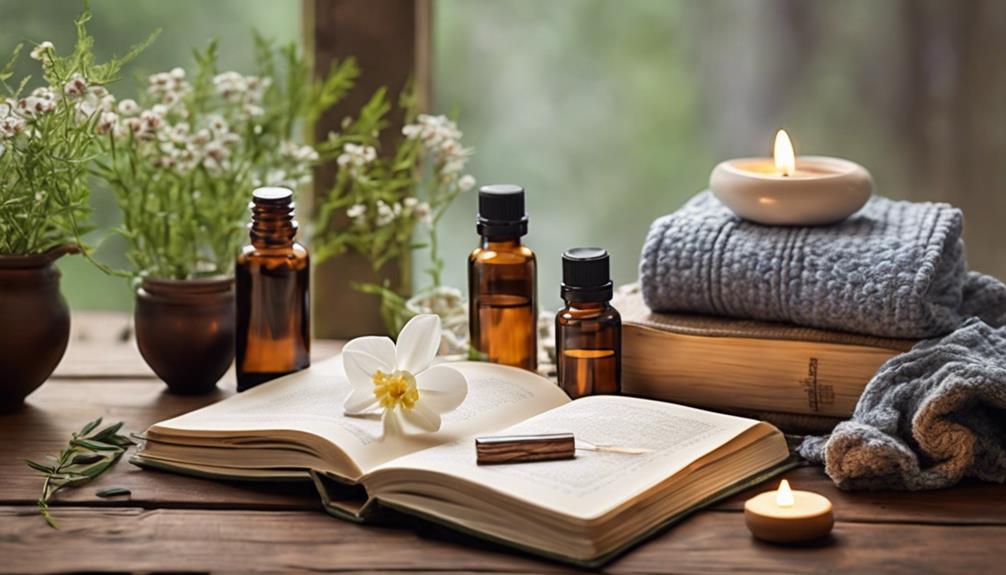
Promoting employee well-being and relaxation, wellness and self-care kits have become a popular choice for company retreat gifts. These kits offer a holistic approach to wellness, including items like candles, bath salts, vital oils, and stress-relief products, creating a tranquil experience for employees.
Here are three crucial items commonly found in wellness kits:
- Necessary Oil Diffuser: Aromatherapy can help reduce stress and anxiety, creating a calming atmosphere during virtual retreats or in the office.
- Yoga Mat: Encouraging employees to take a break and engage in some physical activity can boost morale and productivity, contributing to overall well-being.
- Fitness Tracker: Monitoring daily activity levels and promoting movement, fitness trackers can motivate employees to stay active and maintain a healthy lifestyle even during remote work situations.
These self-care products not only facilitate relaxation but also foster a positive work environment by prioritizing employee wellness and stress-relief.
Tech Gadgets and Accessories
Let's explore the latest tech trends that can elevate our retreat experience.
From useful accessories for work like portable chargers to fun gadgets for leisure such as Bluetooth speakers, there's something for everyone.
These tech gadgets and accessories are sure to enhance productivity and foster team bonding during our time away.
Latest Tech Trends
When exploring the latest tech trends in gadgets and accessories, wireless earbuds stand out as a popular choice for their productivity and convenience.
Bluetooth speakers offer high-quality sound for music enthusiasts, while portable chargers provide on-the-go charging solutions for various electronic devices.
For those seeking enhanced viewing experiences, smartphone magnifiers and projectors are excellent options. Mini telescopes cater to outdoor exploration and stargazing activities, adding a sense of wonder to any adventure.
Staying up-to-date with the latest tech trends ensures you're equipped with cutting-edge tools to enhance both work and leisure activities. Embracing these innovations can boost productivity and enjoyment in the modern world of electronic devices.
Useful Accessories for Work
Enhance your work efficiency and productivity with these must-have tech gadgets and accessories tailored for the modern professional.
Wireless Earbuds are a crucial choice, offering convenience and enhanced focus.
Bluetooth Speakers not only provide music benefits but are also great for team-building activities or relaxation sessions during retreats.
Necessary Chargers are vital for keeping devices powered up, ensuring employees stay connected even on the go.
Smartphone Magnifiers and Projectors come in handy for presentations during team-building activities.
Mini Telescopes add a fun element to outdoor exploration and team-building exercises.
Investing in these tech accessories can elevate your work experience and make company retreats more engaging and productive.
Fun Gadgets for Leisure
Amidst the hustle and bustle of work, incorporating fun gadgets for leisure can add an exciting element to company retreats and foster team bonding. Here are three must-have tech gadgets for leisure activities:
- Wireless Earbuds: Enhance productivity and focus during leisure activities while enjoying your favorite music or podcast without the guarantee of tangled wires.
- Bluetooth Speaker: Provide high-quality music benefits for relaxation and entertainment, creating a lively atmosphere during team gatherings or outdoor activities.
- Portable Chargers: Make convenient charging solutions for tech gadgets on the go, keeping everyone connected and powered up throughout the retreat.
These gadgets not only elevate leisure experiences but also promote collaboration and camaraderie among team members.
Food and Beverage Experiences

Let's tantalize taste buds with exquisite Tasting Menu Pairings and shake things up with a Mixology Workshop for a fun twist at company retreats.
These experiences not only elevate the culinary journey but also foster team bonding through shared enjoyment of delectable creations.
Including these food and beverage delights is sure to leave a lasting impression and enhance the overall retreat experience.
Tasting Menu Pairings
Curate an unforgettable culinary journey for your company retreat with Tasting Menu Pairings, where food and beverage experiences blend seamlessly to delight your team's senses. Here are three reasons why this experience is a must-have for your next retreat:
- Curated Pairings: Indulge in meticulously selected combinations like wine and cheese, craft beer and snacks, or gourmet desserts and cocktails.
- Interactive Bonding: Engage in a shared tasting experience that fosters teamwork and camaraderie among colleagues.
- Memorable Moments: Create lasting memories with unique flavors tailored to match the retreat's theme, adding a personalized touch to the event.
Elevate your retreat atmosphere and treat your team to an immersive culinary adventure that will leave a lasting impression.
Mixology Workshop Fun
Immerse your team in a dynamic hands-on experience with mixology workshops, enhancing camaraderie and creativity at your company retreat. These interactive sessions offer the perfect blend of team building and bonding, as participants get to craft cocktails while learning from skilled bartenders. The workshops are tailored to cater to diverse tastes within the group, whether they prefer mocktails, classic cocktails, or themed drinks. Picture a setting where your team is engaged in a fun and memorable experience, exchanging ideas and enjoying the art of mixology. By incorporating mixology workshops, you can create a lively atmosphere that fosters teamwork and leaves a lasting impression on your employees.
| Benefits | Description |
|---|---|
| Team Building | Craft cocktails together, enhancing teamwork skills |
| Bonding | Share a unique experience, fostering camaraderie |
| Interactive | Hands-on learning with professional mixologists |
| Tailored Experience | Customize drinks to suit diverse preferences |
Creative Team-Bonding Workshops

Engage your team in dynamic and interactive workshops that foster collaboration and strengthen bonds among team members. Team-bonding workshops are crucial for enhancing productivity, fostering creativity, and creating a positive work environment. Here are three key aspects to take into account when planning these workshops:
- Customized Activities:
Tailoring the activities to fit your team's specific needs and goals can make the experience more impactful. From trust falls to problem-solving challenges, customization guarantees that the workshop resonates with your team members, leading to better engagement and outcomes.
- Enhancing Communication:
These workshops provide a platform for team members to improve their communication skills, both verbally and non-verbally. By engaging in activities that demand effective communication, individuals learn to listen actively, express ideas clearly, and work together cohesively.
- Building Trust and Morale:
Through collaborative tasks and team-building exercises, trust is developed among team members, leading to increased morale and a stronger sense of unity. When team members trust each other, they're more likely to support one another, share responsibilities, and work towards common goals.
Frequently Asked Questions
What Should I Pack for an Office Retreat?
We should pack versatile clothing like layers and comfy shoes, along with crucial like sunscreen and water bottles. Don't forget personal items and work materials. Check for gear needed for activities. Remember a journal and camera for memories!
How Do I Prepare for a Company Retreat?
We plan meticulously for the company retreat, ensuring every detail is perfect. From scheduling activities to organizing transport, we leave no stone unturned. Our goal is to create a memorable experience for all attendees.
What Is Another Name for a Staff Retreat?
Another name for a staff retreat is a corporate retreat or team-building retreat. It's a gathering of employees outside the workplace for team bonding and professional development. These events focus on enhancing teamwork, communication, and morale.
What Happens at a Company Retreat?
At a company retreat, we engage in team-building activities, workshops, and relaxation. These events boost morale, foster communication, and strengthen team dynamics. They provide a break from routine, encourage creativity, and enhance employee engagement.
Conclusion
To sum up, we've explored a range of creative company retreat gift ideas to enhance the overall experience and show appreciation to employees.
These unique gifts not only cater to various interests and needs but also promote sustainability and team bonding.
By incorporating these thoughtful gifts into your retreat planning, you can elevate the experience and create lasting memories for all involved.
- About the Author
- Latest Posts
Introducing Ron, the home decor aficionado at ByRetreat, whose passion for creating beautiful and inviting spaces is at the heart of his work. With his deep knowledge of home decor and his innate sense of style, Ron brings a wealth of expertise and a keen eye for detail to the ByRetreat team.
Ron’s love for home decor goes beyond aesthetics; he understands that our surroundings play a significant role in our overall well-being and productivity. With this in mind, Ron is dedicated to transforming remote workspaces into havens of comfort, functionality, and beauty.
-
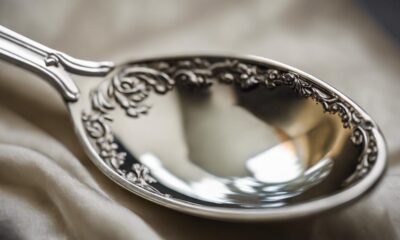
 Vetted1 hour ago
Vetted1 hour ago15 Best Silver Polish Brands to Make Your Silver Shine Like New
-
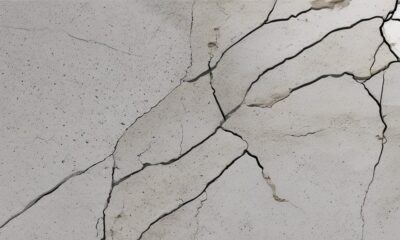
 Vetted5 days ago
Vetted5 days ago15 Best Fillers for Concrete Cracks – Expert Recommendations and Reviews
-

 Vetted1 week ago
Vetted1 week ago15 Best Plants for Large Pots to Transform Your Outdoor Space
-

 Vetted6 days ago
Vetted6 days ago15 Best Fairy Lights to Transform Your Space With Magical Illumination
-

 Vetted1 week ago
Vetted1 week ago15 Best Folding Beds for Small Spaces – Space-Saving Solutions for Comfort and Convenience
-

 Vetted1 week ago
Vetted1 week ago15 Best Waterproof Flooring Options for Your Bathroom – Ultimate Guide & Reviews
-

 Vetted2 weeks ago
Vetted2 weeks ago15 Best Grocery Carts to Make Shopping a Breeze
-

 Vetted1 day ago
Vetted1 day ago15 Best Subfloor Options for Your Basement Renovation – Ultimate Guide

















